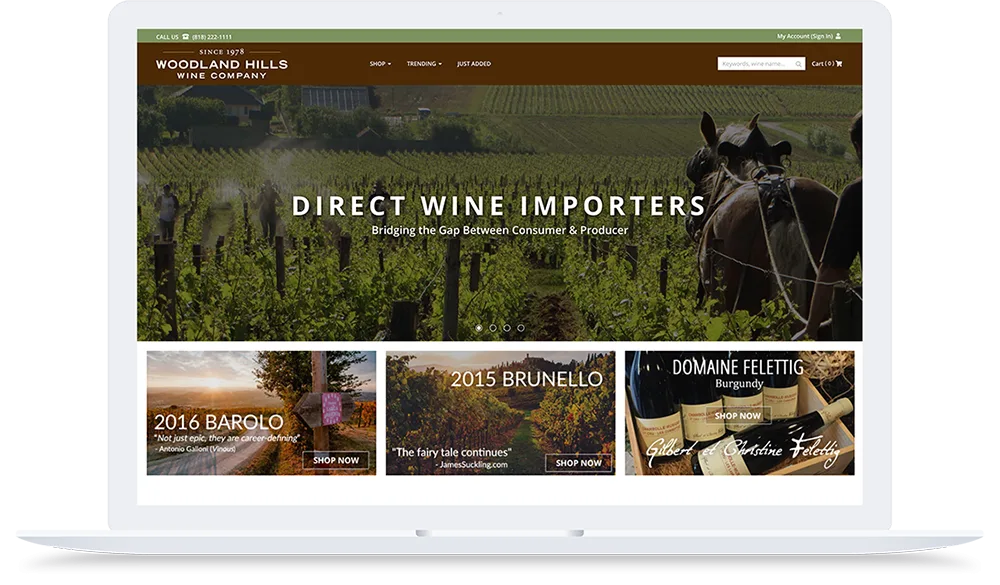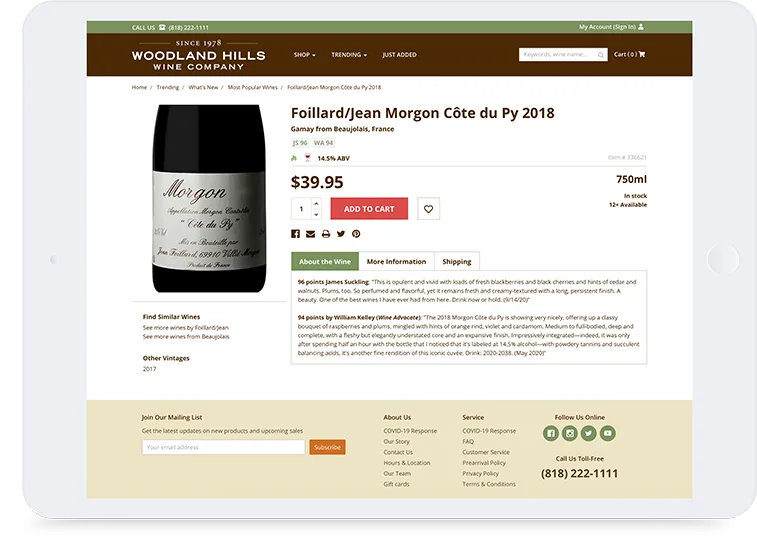California Wine Company Ages Well with BigCommerce
See first-hand the features that empower businesses like Woodland Hills Wine Company to grow with BigCommerce.

See first-hand the features that empower businesses like Woodland Hills Wine Company to grow with BigCommerce.

increase in organic search conversion rate
increase in organic search revenue
increase in revenue and conversion rate from all traffic sources, respectively
Metrics compares Jul. 1–Sept. 30, 2019 (pre-BigCommerce) to Jul. 1–Sept. 30, 2020 (post-BigCommerce).
Woodland Hills Wine Company got its start in 1978 as the small, mom and pop family-owned business, Northridge Hills Liquor. The company’s move towards wine began when its founder, Paul Smith, noticed the California wine market was beginning to grow. Paul struck while the iron was hot and established relationships with winery owners throughout California.
His efforts paid off. He was able to leverage those relationships into access to some of the largest wine allocations in the country. Because vineyards can only produce so much wine in a given year, this was a big win for the company.
While still operating as Northridge Hills Liquor in 1991, a major earthquake struck and completely devastated the area. The building was destroyed, as was most of the store’s inventory. But, as things turned out, this setback became a set up for a brighter future. Paul was forced to seek new clients outside of the local area, and began advertising, selling and shipping wine nationwide.
As Paul stretched and grew, so did the business. In 1998, the store moved to its current location in Woodland Hills, California. The new space gave the newly named company, Woodland Hills Wine Company, about four times the square footage it once had. And, the growth didn’t stop there. Woodland Hills Wine Company expanded internationally, importing wines from places like France, Italy and Germany. These are the places, like Domaine de la Romanée-Conti in Burgundy, France, where a bottle of wine can easily sell for $3,000 up to $15,000 a bottle.
Our specialty is in collector-based wines. That's really our niche. As crazy as it sounds, there are more people that want to buy a $3,000 bottle of wine than there are bottles available. Our customers have expectations about the quality we deliver and our website is proving to be part of that experience.
Prior to BigCommerce we had run our website on AspDotNetStorefront's platform and Infinity by Intershop before that. Our very first site was a home-grown solution so we've seen it all. All three solutions were like being in a bad relationship and then finally finding “the one” in BigCommerce.
We were drawn to the idea of offloading PCI compliance and software maintenance and upgrades and having BigCommerce's SaaS solution assume those responsibilities. Over the years, we struggled with the time and expense of maintaining PCI compliance. Switching to BigCommerce has given us more time to focus on what we do best, selling wine.
We were looking for something that would give us PCI compliance as well as industry- and brand-specific features and customizations that no platform offered. We knew we needed to have a platform that was flexible enough to allow us to make those changes.
Personally, I was really pushing hard for the walled-garden of a SaaS solution. I wanted someone else to host and manage the servers and platform. I also wanted updates and payment integrations to be handled by somebody else. However, I wanted to retain a high level of control through JavaScript, HTML, or an API.
Those were the key things we were looking at. Over and over again, we kept coming back to BigCommerce being the best of breed of what we were looking for. We saw what we could do with the Stencil framework and believed it would serve our needs.
We looked at Shopify Plus and Magento Enterprise. Quickly, both of those fell off the radar. Magento has a database structure completely contrary to our Microsoft SQL server environment. As we started to look at the API and the integration, we found it was very clunky and felt it was far too complex. We spoke with a number of prior and existing Magento users who all expressed significant frustration both with platform maintenance and platform limitations. It felt like you needed a degree in Magento engineering just to maintain basic functionality.
Another big reason Magento fell off was due to product support – or the lack of it. That really was one of the main reasons I was so bullish on BigCommerce — the depth of the teams, the number of teams that were involved from the solutions architects, to the sales teams, to the sales engineers, to the implementation teams and project managers. That was such an important piece because we've worked with companies before where that didn’t exist and it's so important to have.
Shopify fell off simply because the back end was fairly limited. We felt that it was designed to be “keep it simple, stupid.” It felt like it was designed for someone who didn't have a lot of requirements or wanted a ready built solution to run their site. We needed more sophistication.
“We were drawn to the idea of offloading PCI compliance and software maintenance and upgrades and having BigCommerce's SaaS solution assume those responsibilities.”
JON MORGAN IT PROJECT MANAGER, WOODLAND HILLS WINE COMPANY
“Personally, I was really pushing hard for the walled-garden of a SaaS solution. I wanted someone else to host and manage the servers and platform. I also wanted updates and payment integrations to be handled by somebody else. However, I wanted to retain a high level of control through JavaScript, HTML, or an API.”
JON MORGAN IT PROJECT MANAGER, WOODLAND HILLS WINE COMPANY
Patrick was our BigCommerce Solutions Architect and was an incredible asset to our project. He had an answer or a solution for everything we threw at him. There were undocumented things we wanted to do with the API that just didn't seem possible. At times we had some difficulty following the documentation for the API. Patrick was always quick to step in and provide clear instruction on how to achieve and maximize the efficiency of our efforts.
He also stepped in to help us develop a custom payment application solution. He's the one who guided us through the process. There were a couple of times where we ran into some issues on our side where things weren’t working properly. Patrick was always the guy who would step in and say, "Here's what it is, and here's how we fix it." If he didn't have the answer, he would go find out and would always come back and provide a very thorough, high-level amount of detail for how to achieve what we were after.
That really was one of the main reasons I was so bullish on BigCommerce -- the depth of the teams, the number of teams that were involved from the solutions architects, to the sales teams, to the sales engineers, to the implementation teams and project managers.
JON MORGAN IT PROJECT MANAGER, WOODLAND HILLS WINE COMPANY

BigCommerce APIs are helping us do so much — inventory management, product and customer updates. We’re able to download orders and push shipments. We've just recently completed gift card synchronization between systems. For the first time ever, we're actually going to have a system where if I buy a gift card online, it can be redeemed in the store. If I buy a gift card in the store, we can create it in BigCommerce and it can be redeemed on the site. We synchronize those balances. We've been using the APIs for quite a lot and I expect that we'll continue to expand on that.
Then there are times when a customer orders wine, but will want us to hold it for a future date. We needed a solution where we could charge a transaction against that customer's originating card from the original order. Working with Patrick, we came up with a program that allows our order processing teams to charge additional payments to a credit card that was used in BigCommerce. That's one of those things that only BigCommerce gave us capability to do.
The apps that are big for us? Number one, hands down is a Mailchimp. The Mailchimp integration has been really solid for us and we're doing very well with it. In addition to that, we're currently looking at and scoping out how to use Mailchimp's Mandrill for transactional emails and to auto-generate new arrivals emails, and emails based on data within BigCommerce.
Number two, no question, ShipperHQ. We were expecting to spend $20,000 to $30,000 to build a shipping engine ourselves. ShipperHQ eliminated that. I didn't think it was possible for a software program that we didn't write to handle our infinite number of requirements, but they did.
Elfsight has been really, really cool. I've been thrilled with Elfsight. We have signed up for the full-blown package with them, so we have all of their apps and we use it for the maps, contact forms, and popup messaging. I mean, we haven't even touched on everything that it does, but Elfsight is a fantastic solution that’s worth every penny.
Then of course, Google Analytics, because the integration with BigCommerce is so nice. With every platform we've used before, we've had to build all of the analytics integration with Google ourselves. Now, we just put in a few pieces of information and BigCommerce takes care of it for us. I go into Google Analytics and I can see such a granular level of detail that we never had with any other platform.
“BigCommerce APIs are helping us do so much — inventory management, product and customer updates. We’re able to download orders and push shipments.”
JON MORGAN IT PROJECT MANAGER, WOODLAND HILLS WINE COMPANY